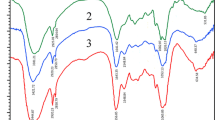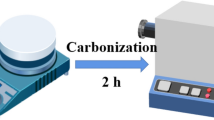Abstract
The adsorption characteristics of phosphorylated Aspergillus niger (AN-P) for uranium(VI) were studied in this work. The AN-P was successfully prepared by the reaction of Aspergillus niger with phosphorus pentoxide in ice-bath under the catalysis of methanesulphonic acid. AN-P was characterized by FT-IR and SEM–EDS. The effects of pH, contact time, initial U(VI) ions concentration, adsorbent dosage and temperature on the adsorption of U(VI) by AN-P were investigated. The isotherm and kinetic data were accurately described by the Langmuir and pseudo-second-order models, respectively. The calculated thermodynamic parameters indicated that the adsorption of U(VI) by AN-P was an spontaneous and endothermic process. This indicated that the AN-P composite is a promising adsorbent for efficient removal of U(VI) from radioactive wastewater.







Similar content being viewed by others
References
Abdelouas A, Lutze W, Nuttall HE (1999) Uranium contamination in the subsurface; characterization and remediation. Rev Miner Geochem 38:433–473
Schöner A, Noubactep C, Büchel G, Sauter M (2009) Geochemistry of natural wetlands in former uranium milling sites (eastern Germany) and implications for uranium retention. Chemie der Erde-Geochemistry 69:91–107
Wang Z, Tebo BM, Giammar DE (2014) Effects of Mn(II) on UO2 2+ dissolution under anoxic and oxic conditions. Environ Sci Technol 48:5546–5554
Blake JM, Avasarala S, Artyushkova K, Ali AMS, Brearley AJ, Shuey C, Robinson WP, Nez C, Bill S, Lewis J, Hirani C, Pacheco JSL, Cerrato JM (2015) Elevated concentrations of U and co-occurring metals in abandoned mine wastes in a northeastern Arizona Native American community. Environ Sci Technol 49:8506–8514
Lopez-Solis R, François J (2018) The breed and burn nuclear reactor: a chronological, conceptual, and technological review. Int J Energy Res 42:953–965
Shi Z, Liu C, Zachara JM, Wang ZM, Deng BL (2009) Inhibition effect of secondary phosphate mineral precipitation on uranium release from contaminated sediments. Environ Sci Technol 43:8344–8349
Stucker V, Ranville J, Newman M, Peacock A, Cho J, Hatfield K (2011) Evaluation and application of anion exchange resins to measure groundwater uranium flux at a former uranium mill site. Water Res 45:4866–4876
Zhou L, Shang C, Liu Z, Huang G, Adesina AA (2012) Selective adsorption of uranium(VI) from aqueous solutions using the ion-imprinted magnetic chitosan resins. J Colloid Interf Sci 366:165–172
Vivero-Escoto JL, Carboni M, Abney CW, deKrafft KE, Lin WB (2013) Organo-functionalized mesoporous silicas for efficient uranium extraction. Micropor Mesopor Mat 180:22–31
Singh SK, Misra SK, Sudersanan M, Dakshinamoorthy A (2009) Studies on the recovery of uranium from phosphoric acid medium by D2EHPA/n-dodecane supported liquid membrane. Sep Sci Technol 44:169–189
Wang CS, Liu Y, He H, Gao FX, Liu LS, Chang SW, Guo JH, Chang L, Li RX, Ouyang YG (2013) Electrochemical separation of uranium and cerium in molten LiCl–KCl. J Radioanal Nucl Chem 298:581–586
Zhang Z, Dong Z, Wang X, Ying D, Cao X, Wang Y, Hua R, Feng H, Chen J, Liu Y, Hu B, Wang X (2019) Synthesis of ultralight phosphorylated carbon aerogel for efficient removal of U(VI): batch and fixed-bed column studies. Chem Eng J 370:1376–1387
Guo X, Chen R, Liu Q, Liu J, Zhang H, Yu J, Li R, Zhang M, Wang J (2019) Graphene oxide and silver ions co-assisted zeolitic imidazolate framework for antifouling and uranium enrichment from seawater. ACS Sustainable Chem Eng 7:6185–6195
Dutta RK, Shaida MA, Singla K, Das D (2019) Highly efficient adsorptive removal of uranyl ions by a novel graphene oxide reduced by adenosine-monophosphate (RGO-AMP). J Mater Chem A 7:664–678
Hosseini S-H, Rahmani-Sani A, Jalalabadi Y, Karimzadeh M, Hosseini-Bandegharaei A, Kharghani K, Allahabadi A (2015) Preconcentration and determination of ultra-trace amounts of U(VI) and Th(IV) using titan yellow-impregnated Amberlite XAD-7 resin. Int J Environ Anal Chem 95:277–290
Hosseini-Bandegharaei A, Allahabadi A, Rahmani-Sani A, Rastegar A, Khamirchi R, Mehrpouyan M, Hekmat-Shoar R, Pajohankia Z (2016) Thorium removal from weakly acidic solutions using titan yellow-impregnated XAD-7 resin beads: kinetics, equilibrium and thermodynamic studies. J Radioanal Nucl Chem 309:761–776
Hosseini-Bandegharaei A, Hosseini MS, Jalalabadi Y, Nedaie M, Sarwghadi M, Taherian A, Hosseini E (2013) A novel extractant-impregnated resin containing carminic acid for selective separation and pre-concentration of uranium(VI) and thorium(IV). Int J Environ Anal Chem 93:108–124
Hosseini MS, Hosseini-Bandegharaei A (2010) Selective extraction of Th(IV) over U(VI) and other co-existing ions using eosin B-impregnated Amberlite IRA-410 resin beads. J Radioanal Nucl Chem 283:23–30
Li L, Hu N, Ding D, Xin X, Wang YD, Xue JH, Zhang H, Tan Y (2015) Adsorption and recovery of U(VI) from low concentration uranium solution by amidoxime modified Aspergillus niger. RSC Adv 5:65827–65839
Samuel MS, Subramaniyan V, Bhattacharya J, Chidambaram R, Qureshi T, Singh NDP (2018) Ultrasonic-assisted synthesis of graphene oxide – fungal hyphae: an efficient and reclaimable adsorbent for chromium(VI) removal from aqueous solution. Ultrason Sonochem 48:412–417
Cai Y, Chen L, Yang S, Xu L, Qin HB, Liu Z, Chen L, Wang X, Wang S (2019) Rational Synthesis of Novel Phosphorylated Chitosan-Carboxymethyl Cellulose Composite for Highly Effective Decontamination of U(VI). ACS Sustain Chem Eng 7:5393–5403
Sun Q, Aguila B, Perman J, Ivanov AS, Bryantsev VS, Earl LD, Abney CW, Wojtas L, Ma S (2018) Bio-inspired nano-traps for uranium extraction from seawater and recovery from nuclear waste. Nat Commun 9:1644–1652
Gao JK, Hou LA, Zhang GH, Gu P (2015) Facile functionalized of SBA-15 via a biomimetic coating and its application in efficient removal of uranium ions from aqueous solution. J Hazard Mater 286:325–333
Gładysz-Płaska A, Majdan M, Tarasiuk B, Sternik D, Grabias E (2018) The use of halloysite functionalized with isothiouronium salts as anorganic/inorganic hybrid adsorbent for uranium(VI) ions removal. J Hazard Mater 354:133–144
Gao MW, Zhu GR, Wang XH, Wang P, Gao CJ (2015) Preparation of short channels SBA-15-PVC membrane and its adsorption properties for removal of uranium (VI). J Radioanal Nucl Chem 304:675–682
Wang YL, Song LJ, Zhu L, Guo BL, Chen SW, Wu WS (2014) Removal of uranium (VI) from aqueous solution using iminodiacetic acid derivative functionalized SBA-15 as adsorbents. Dalton Trans 43:3739–3749
Qian Y, Yuan Y, Wang H, Liu H, Zhang J, Shi S, Guo Z, Wang N (2018) Highly efficient uranium adsorption by salicylaldoxime/polydopamine graphene oxide nanocomposites. J Mater Chem A 6:24676–24685
Abdel-Gawad KM, Hifney AF, Fawzy MA (2017) Technology optimization of chitosan production from Aspergillus niger biomass and its functional activities. Food Hydrocolloid 63:593–601
Jayakumar R, Selvamurugan N, Nair SV, Tokura S, Tamura H (2008) Preparative methods of phosphorylated chitin and chitosan-An overview. Int J Biol Macromol 43:221–225
Zhang H, Xue JH, Hu N, Sun J, Ding DX, Wng YD, Li L (2016) Selective removal of U(VI) from low concentration wastewater by functionalized HKUST-1@H3PW12O40. J Radioanal Nucl Chem 308:865–875
Ding C, Cheng W, Sun Y, Wang X (2015) Novel fungus-Fe3O4 bio-nanocomposites as high performance adsorbents for the removal of radionuclides. J Hazard Mater 295:127–137
Priyadarshini N, Sampath M, Kumar S, Mudali UK, Natarajan R (2013) A combined spectroscopic and light scattering study of hydrolysis of uranium(VI) leading to colloid formation in aqueous solutions. J Radioanal Nucl Chem 298(3):1923–1931
Ho YS, Mckay G (2000) The kinetics of sorption of divalent metal ions onto sphagnum moss peat. Water Res 34:735–742
Ho YS, Mckay G (1999) Pseudo-second order model for sorption processes. Process Biochem 34:451–465
Simsek I, Karatas M, Basturk E (2013) Cu(II) removal from aqueous solution by ureolytic mixed culture (UMC). Colloid Surface B 102:479–483
Liu Y, Liu Y, Cao X, Hua R, Wang Y, Pang C, Hua M, Li X (2011) Biosorption studies of uranium (VI) on cross-linked chitosan: isotherm, kinetic and thermodynamic aspects. J Radioanal Nucl Chem 290:231–239
Li B, Sun Q, Zhang Y, Abney CW, Aguila B, Lin W, Ma S (2017) Functionalized porous aromatic framework for efficient uranium adsorption from aqueous solutions. ACS Appl Mater Interfaces 9:12511–12517
Yang Y, Wang J, Wu F, Ye G, Yi R, Lu Y, Chen J (2016) Surface-initiated SET-LRP mediated by mussel-inspired polydop- amine chemistry for controlled building novel core-shell magnetic nanoparticles for highly-efficient uranium enrichment. Polym Chem 7:2427–2435
Liu X, Wu J, Zhang S, Ding C, Sheng G, Alsaedi A, Hayat T, Li J, Song Y (2019) Amidoxime-functionalized hollow carbon spheres for efficient removal of uranium from wastewater. ACS Sustain Chem Eng 7:10800–10807
Song S, Huang Q, Cheng G, Wang W, Lu Z, Zhang R, Wen T, Zhang Y, Wang J, Wang X (2019) Immobilization of U(VI) on hierarchical NiSiO@MgAl and NiSiO@NiAl nanocomposites from wastewater. ACS Sustain Chem Eng 7:3475–3486
Yin L, Hu Y, Ma R, Wen T, Wang X, Hu B, Yu Z, Hayat T, Alsaedi A, Wang X (2019) Smart construction of mesoporous carbon templated hierarchical Mg-Al and NiAl layered double hydroxides for remarkably enhanced U(VI) management. Chem Eng J 359:1550–1562
Lima EC, Hosseini-Bandegharaei A, Moreno-Piraján JC, Anastopoulos I (2019) A critical review of the estimation of the thermodynamic parameters on adsorption equilibria. Wrong use of equilibrium constant in the Van’t Hoof equation for calculation of thermodynamic parameters of adsorption. J Mol Liq 273:425–434
Acknowledgements
This work was supported by the Key R&D Program of Hunan Province (2018SK2029), the National Natural Science Foundation of China (51704170), the Natural Science Foundation of Hunan Province (2017JJ3276 and 2018JJ3423), the Department of Education of Hunan Province (17B226), and the China Postdoctoral Science Foundation funded Project (2017M612569).
Author information
Authors and Affiliations
Corresponding author
Ethics declarations
Conflict of interest
All the authors declare that they have no conflict of interest.
Additional information
Publisher's Note
Springer Nature remains neutral with regard to jurisdictional claims in published maps and institutional affiliations.
Electronic supplementary material
Below is the link to the electronic supplementary material.
Rights and permissions
About this article
Cite this article
Dai, Z., Xiang, H., Lu, W. et al. Synthesis and characterization of phosphorylated Aspergillus niger for effective adsorption of uranium(VI). J Radioanal Nucl Chem 323, 379–386 (2020). https://doi.org/10.1007/s10967-019-06917-8
Received:
Published:
Issue Date:
DOI: https://doi.org/10.1007/s10967-019-06917-8




